By SONG Jianlan
In an era where artificial intelligence (AI) is permeating many aspects of scientific research activity, what science and technology (S&T) journals can do to uphold research integrity and secure scholarly quality? What kind of revolution is needed in such a rapidly drifting world to hold on to the essential value of science?
Focusing on quality development of S&T journals, an international symposium occurring from June 16 to 18 provided a platform for different stakeholders to exchange their best thoughts and practices.
The dialogue was arranged under three themes: quality control and high-quality development of S&T journals; knowledge services and impact enhancement of S&T journals through effective approaches; and publishing ethics and research evaluation in science. The themes were sandwiched by sessions of discussions to allow further explorations. Invited speakers represented different fronts of the academic publication sector: internationally prominent academic publishers like Elsevier and Springer Nature; prestigious journal clusters like Cell and Science China; publishing associations like the Publishers Association of China (PAC), the International Association of Scientific, Technical and Medical Publishers (STM), and the American Chemical Society (ACS) Publications; data analysts like Clarivate; and leading scientists who have intensively involved in academic publishing, having assumed the duty of editors-in-chief or sitting on editorial committees.
The symposium is part of the serial events sponsored by the Academic Divisions of the Chinese Academy of Sciences (CAS) in celebration of its 70th founding anniversary.
CAS Member Prof. WANG Enge, a prestigious physicist and current general editor-in-chief of the journal cluster Science China, worked as Executive Chair of the symposium. “The CAS Academic Divisions has attached great importance to the development of S&T journals,” he introduced. “With speakers and participants from different frontiers of academic publishing, we hope to explore together the strategy and pathway for quality development of S&T journals, addressing issues like conditions and elements for quality development, digital platforms and knowledge service, academic publishing and exchanges powered with AI, academic quality control, research integrity and publishing ethics, academic evaluation and S&T journal publication, and so on,” he remarked.
“Let us take the opportunity of this symposium to enhance our exchange and cooperation in S&T journal publishing, and join hands to forge high-level S&T journals of international influence, based on our consensus for inclusive development. In this way, we will be able to promote global academic exchanges and the advancement of human civilization,” said CAS Member Prof. BAO Xinhe, a renowned chemist, in his address on behalf of the sponsor. “We sincerely hope this brain storming can produce some scintillating ideas,” he added.
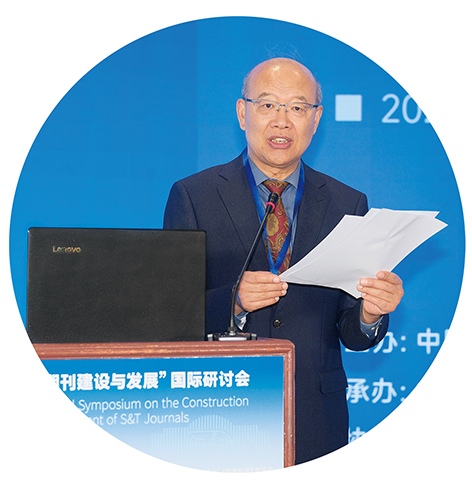
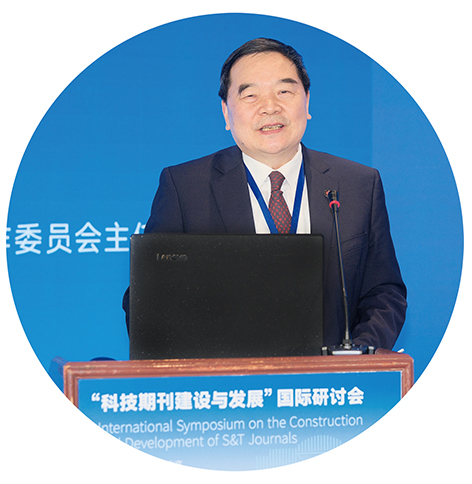
CAS Member Prof. WANG Enge (left) introduces the background of the symposium as the Executive Chair of the symposium. CAS Member Prof. BAO Xinhe (right) addresses the symposium. (Photos: Science China Press)
Quality Research vs Quality Journals: A Paradox in China
How to strengthen the international influence of their S&T journals has remained a central issue on the agenda of Chinese academic publishers. Over the past decade, Chinese authors have contributed a large share of high-impact papers of the world, frequently topping billboards represented by the Nature Index, which tracks 145 high-quality journals as carriers for high-quality research output. As shown by the Nature Index 2025 Research Leaders released on June 11, eight out of the top 10 academic institutions are from China. As the highest national research institution of China, CAS has topped this index for 13 years in a row, producing the largest volume of the analyzed papers. Forming a sharp contrast, however, only a fraction of these papers is published in journals of Chinese origin. As a result, indigenous journals of China have been perplexed with an “elite paper drain” and subsequently lowered influence.
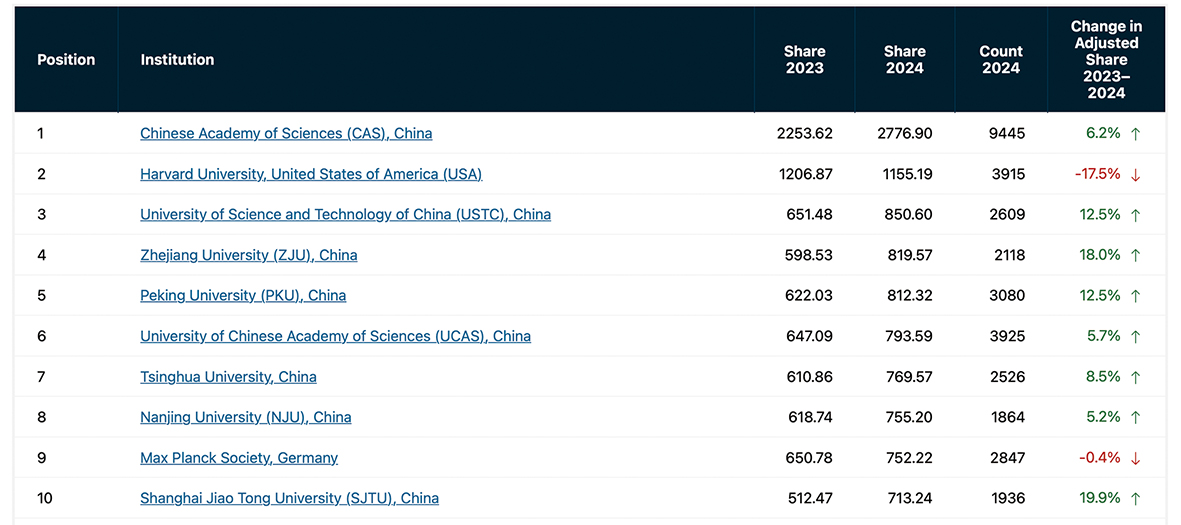
Chinese Academy of Sciences heads the top 10 academic institution list as recently released in 2025 Nature Index Leaders. It has topped the billboard 13 times in a row.
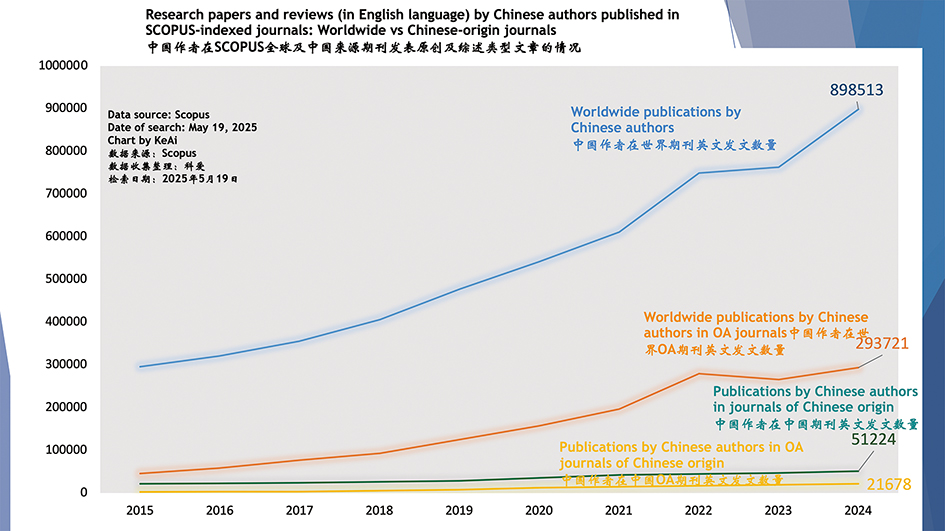
Journals of China are faced with a paradox: the soar in academic publications contributes very little to domestic journals. (Image extracted from the slides of the speech “Seizing Opportunities and Advancing the Development of China’s STM Journals through Effective Approaches” given by Mr. WU Shulin, PAC Chairman; English translation added by the author.)
This plight is believed, to some extent, to have resulted from an approach to assessing research performance adopted around thirty years ago, as mirrored in the talks by invited speakers. This approach gives too much weight on the “impact factor,” a metric that measures the average frequency of citation for the papers in a certain journal. In the pursuit of high impact-factor publications, Chinese authors began to favor Science, Nature, Cell, and other internationally influential journals over domestic ones. And the latter, new for competition on the arena of metrics, stayed underdogs in face with the international giants, and kept struggling in the head tide.
However, despite the adversity, some journals still broke through and stood out. Under the theme “quality control and high-quality development of S&T journals,” the editors-in-chief of two such representative journals shared their experiences and insights.
In his speech, CAS Member Prof. MEI Hong, the editor-in-chief of Science China · Information Science, emphasized the important role of the scholarly leadership of the journal, namely the editorial committee. The key to steering the journal out of the low ebb, he said, lay in positioning top scientists at the helm and securing the academic quality of the contents. Since he assumed the term of the editor-in-chief seven years ago, his editorial committee has made great efforts to optimize the contents, control scholarly quality, solicitate contributions, innovate the column setting and organize symposia on disciplinary frontiers, echoing the research progress in the field of information science. Coordinated with improved promotion and communication efforts by the editorial team, the journal harvested rapid increases in impact factors over the past years, and the volume of publications also saw steady rises — the journal has become more and more attractive to authors.
CAS Member Prof. CHEN Fahu, executive editor-in-chief of the journal Science Bulletin, also attached a lot of importance to the role played by the editorial committee in the development of an academic journal.
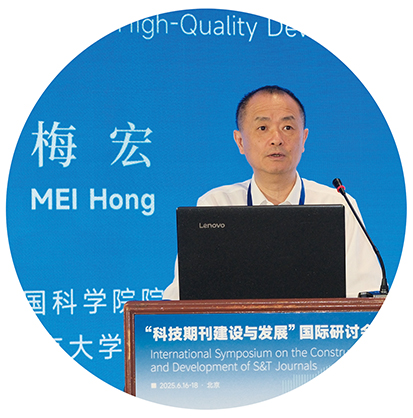
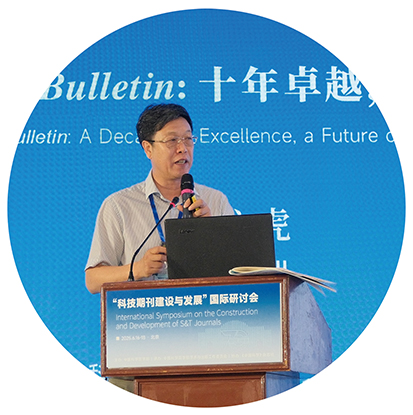
CAS Member Prof. MEI Hong (left), editor-in-chief of Science China · Information Science, and CAS Member Prof. CHEN Fahu (right), executive editor-in-chief of Science Bulletin, share their experience in journal development. (Photos: Science China Press)
Mr. WU Shulin, PAC Chairman and Vice Chairman of the Academic Committee, China Institute for Innovation and Development Strategy, looked at the issue of academic publication from more macroscopic a perspective. Academic journals in China are now seeing unprecedentedly promising opportunities for their quality development, he asserted after analyzing the current socioeconomic situation. Based on a comparison between leading international publishing groups and domestic publishers, however, he highlighted a series of universal problems, including fragmented publishing resources and small scales of individual journals. To make possible further growth, he advocated, the domestic journals need to further open up to the international academic community and enhance exchanges with international leading publishers, to improve their business operation. To overcome the difficulties, he proposed sticking to the essential value of STM publication, and meanwhile reforming the current model of publishing. Specifically, he suggested to build internationally high-level academic publishing groups and journal clusters based on existing major press houses; pay keen attention to open science to better serve the science community; accelerate the digitalization process powered by AI; and learn from internationally leading publishers.
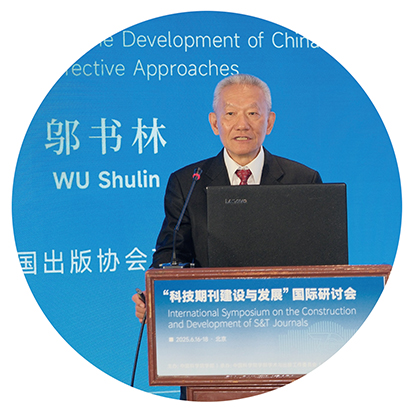
Mr. WU Shulin, PAC Chairman and Vice Chairman of the Academic Committee, China Institute for Innovation and Development Strategy, proposes a strategy for S&T journal development in China. (Photo: Science China Press)
The speech by Dr. John PHAM, editor-in-chief of Cell, a prestigious journal in the field of biology and medicine, provided a meaningful footnote for the landscape of academic publishing. He emphasized the role of S&T journals in serving science research — dissemination, evaluation, curation and synthesis of scientific output, connecting individual literature with the broader disciplinary context, bridging scientists, and caretaking of research integrity. In particular, he underscored the importance of public confidence in research: “Without public confidence, science would mean nothing.” Accordingly, he underlined the essential value of quality peer-review as a gold standard, and openness and transparency as the basis on which trust can be created.
Dr. Sarah TEGEN, Senior Vice President and Chief Publishing Officer of ACS Publications, introduced how ACS enhances quality content and services in support of the global scientific enterprise.
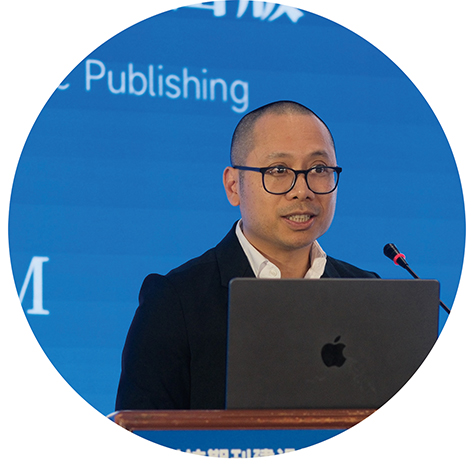
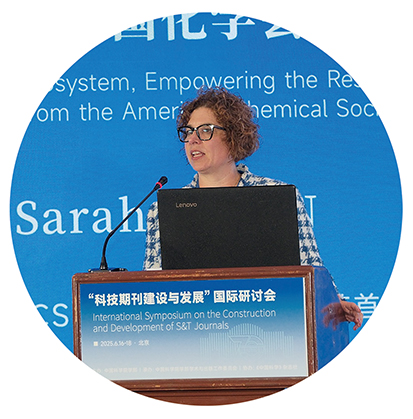
Dr. John PHAM (left), editor-in-chief of Cell, gives a speech on S&T journals’ role in serving academic research. Dr. Sarah TEGEN, Senior Vice President and Chief Publishing Officer of ACS Publications, talks about how ACS enhances quality content and services. (Photos: Science China Press)
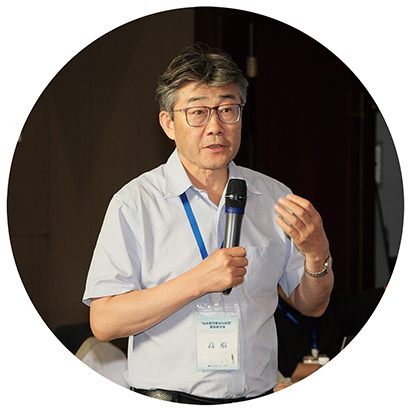
CAS Member Prof. GAO Fu chairs a session under the theme “quality control and high-quality development of S&T journals.” (Photo: Science China Press)
Knowledge Services and Impact Enhancement — Working with AI
AI has been the “elephant in the room” for academic research as well as publication. With no surprise, all the three themes of the symposium unfolded against a common background featuring ubiquitous AI and an accelerating shift of research paradigm. Speakers talked about AI policies, restrictions on AI usage in paper drafting and review process, and also anti-AI toolkits to identify potential AI-generated contents; also, they talked about taking the tide of AI to improve efficiency in publishing and communication.
Fighting against AI misapplication
A common concern is the misuse of AI in academic research and publishing. Dr. Caroline SUTTON, CEO of STM Association, directly faced this issue in her speech titled “Academic Publishing and Communication in the Context of AI.”
As a leading trade association for academic and professional publishers, STM has about 150 members from 17 countries. Approximately 66% of all the journal articles throughout the world are published by its members. “STM has four workstreams on AI and has released white papers emphasizing principles like transparency, accountability, quality, integrity, privacy, security, fairness, and sustainable development,” introduced Dr. SUTTON. She also shared with the audiences STM’s predictions on technological trends, particularly the 2027 trends focusing on digital identity, social responsibility, AI, open science, research integrity, and collaboration. With this complicated vision of the future world, she stressed on AI ethics in scholarly communication, and introduced efforts by STM in this regard. For example, recently STM released guidelines for using AI in academic publishing, and launched the STM Integrity Hub. “Technology is to win against technology,” she remarked. This hub offers AI-driven text detection tools to identify dubious contents, including those produced by generative AI and paper mills. She also shared a most recent draft report on classifying AI use in manuscript preparation, which is open for comments.
Dr. SUTTON also warned of the risks of misusing open access (OA) literature to feed AI in training, asking the question whether the current OA licensing tools and practices fit for purpose. In response to such emerging challenges, she emphasized the importance of enhanced copyright licensing in ensuring responsible AI use in academic publishing.
Open science in the AI era
The speech by soil scientist Prof. ZHU Yongguan, CAS Member and Director General of the Research Center for Eco-environmental Sciences of CAS, accented more on the openness of science in face with AI. Author of over 600 papers in international journals and a highly-cited researcher as selected by the Web of Science from 2016 straight to 2024, ZHU himself has been working as the editor-in-chief for two journals, Soil Ecology Letters and Modern Agriculture. He is also a Fellow of the International Science Council (ISC), currently serving as Vice President of ISC.
On behalf of ISC, ZHU shared a recent report released by the council: Key Principles of Scientific Publishing — And the extent to which they are observed, highlighting eight principles of academic publishing. The first of the highlighted principles is universal, prompt open access to the record of science, both for authors and readers. He elaborated that science shall be open for all, with no barriers preventing anyone from participating, especially barriers based on ability to pay, institutional privilege, language or geography. Accordingly comes the principle that scientific publications by default should carry open licenses to permit reuse, and allow for text and data mining. Coming the third and fourth are rigorous, timely and ongoing peer review of manuscripts, and the data and observations be concurrently accessible to scrutiny. Other principles included ensuring science record be OA for future generations, publication be adapted to different needs yet meanwhile to facilitate inter-operability between different disciplines and regions; and governance of the dissemination process of scientific knowledge be accountable to the scientific community.
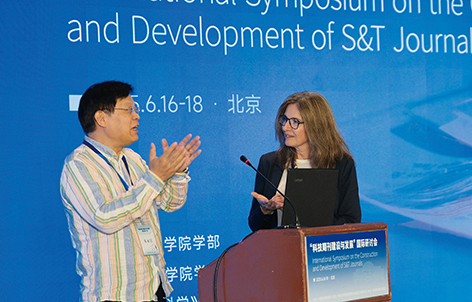
CAS Member Prof. ZHU Yongguan (left), a highly-cited author and Vice President of ISC, shares his ideas with Dr. Caroline SUTTON, CEO of STM Association, at a discussion session. (Photo: Science China Press)
Publish less and publish better
Starting from the above principles, ZHU shared some of his personal thoughts on academic publication.
He recognized the important role of scientific publication as a vital component of knowledge generation and innovation; however, witnessing the exponentially growing volume of academic literature, he raised the question: DO WE REALLY NEED SO MANY PAPERS?
The sheer volume of existing literature has become well beyond human comprehension, he put forward. “It is becoming impractical for any individual to keep pace with the ever-growing body of literature,” he said, “even within their specific areas of interests.” On the other hand, amid the massive literature is a lot of follow-up research of relatively low level of innovation Is this “wasteful” publication? He asked.
Whatever the answer is, he continued, this situation calls for a reassessment of the current publication paradigm. Should we impose limits on the number of papers a researcher can publish, to encourage scientists to publish less and publish better? This situation, he continued, might also call for a shift in the research paradigm, and a reform in the research assessment system to prioritize quality over quantity. “Quality is above all,” ZHU stressed.
Moreover, the science community should take actions to make academic publications accessible to broader communities, he continued, not just in the sense of licensing, but also practically serving the people. In so doing, the research should be targeted at the needs of the public and in return benefit the public; meanwhile, research results should be translated into easy language and be comprehensible for the general public. For this sake, he even initiated launching a new journal named “Science for All.”
To deal with the existing massive volume of literature, he suggested, utilization of AI-facilitated knowledge integration and mapping would be essential for extracting structured knowledge from the massive unstructured texts and data. He introduced the attempts by his team, and concluded that AI technologies, like natural language processing models, could help young scientists scan the literature quickly and hence identify the knowledge gap much more efficiently.
Take a ride with AI
Mr. Arnout JACOBS, President of the Greater China branch of Springer Nature, highlighted the pressing need for a future-focused, researcher-centric publishing platform, against a context where three “seismic shifts” in the industry call for profound transformation of publishing platforms. The three shifts include the trend of open access and open science, the increased digital demands from young researchers, and new opportunities generated by ubiquitous AI. “These changes have put us on a mission to build future-focused, researcher-centric platforms,” he said.
Answering this call, Springer Nature chose to embrace new technologies and the accompany opportunities. Mr. JACOBS shared with the audiences some effective tools and practices developed by the group aimed to meet the new demands in the AI era. Highlighted were two platforms powered with high-tech: the article processing platform Snapp, and the new unified platform Springer Nature Link, which integrates multiple functions to serve researchers.
“Technology, particularly AI, is transforming the publishing process and enabling us to ensure integrity and enhance quality, while increasing speed and efficiency in our core processes,” he said, confirming the positive side of high technology.
Mr. Arnold PIPPEL, senior Vice President of Elsevier, a leading academic publisher in the world, introduced their efforts to empower the research community through technological innovation and high-quality services to address the fast-growing and challenging scholarly publishing market.
Integrating AI and data analysis tools, he said, Elsevier has developed more versatile publishing platforms to meet new demands and construct research integrity. They have provided comprehensive publishing tools and resources to help researchers disseminate their latest results more efficiently, and offered data-driven services such as Scopus and ScienceDirect to enhance the visibility and impact of research.
He also shared their experiences in addressing new challenges, for example the transition from subscription to OA, the crisis of trust in science, and the challenge from paper mills.
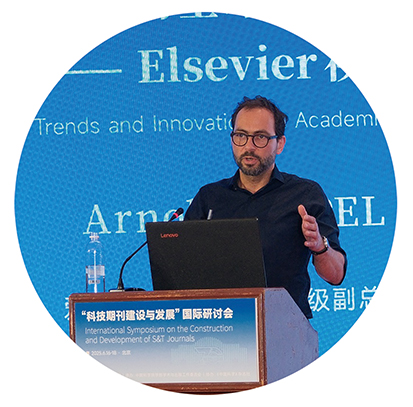
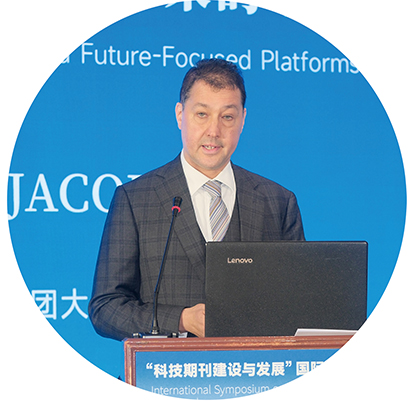
Mr. Arnout JACOBS (left), President of the Greater China branch of Springer Nature, and Mr. Arnold PIPPEL (right), senior Vice President of Elsevier share how they address the challenges posed by AI. (Photos: Science China Press)
Publishing Ethics and Research Evaluation
Research integrity has been taken as the shared responsibility of the whole science community. In an era where AI is playing more and more prominent a role, academic publishers are seeing challenges in guarding the traditional values. Against this context, lots of discussions are going on in terms of AI policies, and how to efficiently identify possible misuse of AI and other compromised materials in academic manuscripts.
At the symposium, participants shared their ideas and experience. The talks echoed the consensus that transparency and integrity are of the most importance in science and scientific publishing. On top of this, as repeatedly mentioned at the symposium, more is needed to secure research ethics; particularly, an optimized assessment mechanism is needed to secure the essential values of science research, and academic publishing as well.
“Alienation in evaluation mechanism”
CAS Member Prof. ZHENG Yongfei, a professor from the University of Science and Technology of China, focused more on the evaluation of academic papers, and the capacity buildup of domestic journals of China. The paradox of “strong research vs weak journals,” he said, reflects the alienation of the academic evaluation system: imbalanced evaluation orientation, lack of international discourse power, and conflicts in technological ethics. As a result, the research activity in China has been inspired and ushered more by the preference of top journal editors and referees, rather than driven by the genuine demands of the social and economic development; and the authorities have neglected considering the actual scholarly quality and innovation of the publications submitted by the applicants in various performance appraisals, including prize considerations.
To strengthen the domestic journals, he advocated a strategy holding on to the essential value of journals. Central to the strategy is establishing a three-dimensional value assessment model, integrating quality, ethics and influence, to replace the one-sided worship of impact factors. Meanwhile, a collaborative ecosystem promoting interdisciplinary integration and intelligent publishing revolution, as well as strengthened policy empowerment aimed at a quality-oriented academic system and innovation-oriented peer-review system, he added, were also needed to overcome the plight.
This strategy, he emphasized, calls for a reform in academic evaluation system from a holistic view.
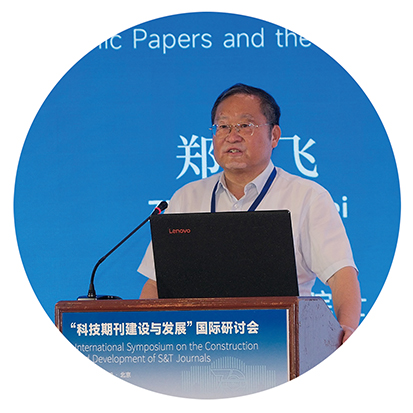
CAS Member Prof. ZHENG Yongfei gives insights on journal evaluation reform and quality development. (Photo: Science China Press)
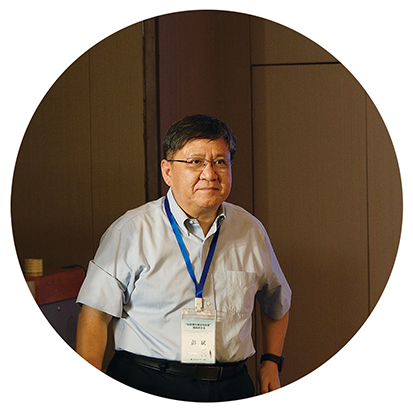
Mr. PENG Bin, general editor-in-chief of Science Press, the publishing house hosting Science China and Science Bulletin, chairs a session under the theme “Publishing ethics and research evaluation in science.” (Photo: Science China Press)
Reform in research evaluation a resonant theme
In a generative AI world, research integrity is ever more important, reiterated Mr. Arnold PIPPEL, senior Vice President of Elsevier. Actually, this theme had reoccurring throughout the whole symposium, representing the consensus of the academic publishing industry. This, also echoed another theme that had become louder and louder across the science community: the call for reform in research assessment system.
Clarivate, a top database service and analysis provider, is celebrating the 50th anniversary of its annual Journal Citation Reports (JCR). According to Mr. Osher GILINSKY, Vice President of Clarivate, in the 2025 version of JCR, they introduced “a small but important policy change” — removed the contributions from retracted papers when calculating the impact factors and other metrics. This purification is expected to enhance the quality of scholarly record, as the steep rising in number of retractions has caught more and more attention.
Clarivate also made efforts to promote responsible research assessment, with emphases given to more comprehensive approach beyond metrics.
“In the long history of ISI, now Clarivate, we have always advocated that publication and citation analysis are meant to be a supplement to peer review,” said Mr. GILINSKY, warning of misuse of point metrics and suggesting more comprehensive approach of evaluation.
Clarivate released in 2013 a manual titled Ten Rules for Using Publication and Citation Analysis and then in 2019 the Profiles Not Metrics to prevent potential misuse and misinterpretation of point metrics. When making metrics for performance evaluation more visually informative, Clarivate also explored a more comprehensive approach to performance assessment, introducing societal impact into their framework of indicators for research evaluation. This framework is to be launched soon as an integral part of their forthcoming Web of Science Research Intelligence platform.
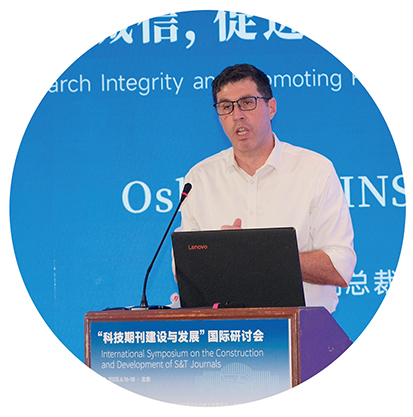
Mr. Osher GILINSKY, Vice President of Clarivate, emphasizes the importance of research integrity and warns of misuse of point metrics in research evaluation. (Photo: Science China Press)
Efforts by Chinese authorities
Over the recent years, the misuse of AI in science research and academic publication has raised great concerns, fueling hot debates on scientific research integrity. By virtue of rigorous peer review and comprehensive editorial and publishing frameworks, scientific journals in China have held on to research integrity and scholarly quality, introduced Prof. LIU Xiaomin, an expert at bibliometrics and research evaluation from the National Science Library, CAS, in her speech. However, at a time when research itself is transiting to a new paradigm in response to the new opportunities and demands brought by AI and data science, academic publishing encounters new challenges, Prof. LIU continued.
Academic misconduct is taking new forms, mainly characterized by the non-repeatability of data and images. Particularly, the steeply rising number of retracted papers per year worried journal publishers. This might have resulted from the widespread application of AI-aided tools in detecting compromised contents, and the stringent regulation from related authorities; however, this shocking increase rings an alarm, indicating misfunctions somewhere.
Publishing regulatory bodies, represented by CAS, have enacted and implemented a series of measures to regulate research activities and counter potential misconduct, said Prof. LIU. Such measures have been taken on different frontiers, including institutional frameworks enforcing research integrity, publishing regulations aimed at optimized workflows, and policies encouraging data submission to designated platforms.
To promote responsible research and publishing, Prof. LIU emphasized, the scientific journals of China must further expand their global academic collaboration networks and establish data interoperability mechanisms with international publishing groups and scholarly organizations. “Building robust publishing integrity standards and accelerating collaborative governance in research integrity are essential to safeguarding the purity of academic research and scientific innovation,” she concluded.
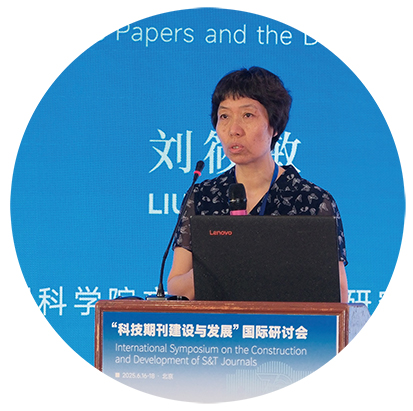
Prof. LIU Xiaomin, an expert in bibliometrics and research evaluation from the National Science Library, CAS, talks about research integrity against the challenges posed by AI. (Photo: Science China Press)
Reminders from CAS Academic Divisions
To purify the research ecology and promote research integrity, the CAS Academic Divisions has issued a series of regulations to remind the scientists of research conducts.
A recent move in this aspect was the “Eight Reminders” for scientists on responsible use of AI released in September 2024. In this notice, the CAS Academic Divisions stipulated that no AI-generated data is allowed to be taken as experiment results in research; AI-generated manuscripts or reference lists are not acceptable; and no AI should be used in peer-review process, nor is it allowed to upload reviewers’ comments onto any unverified AI platform. Wherever AI-generated contents (i.e. images or charts) are used, it should be clearly labeled and stated; also, in AI-involved cases, data security, intellectual property and personal privacy shall be respected and safeguarded. Back in 2023, CAS Academic Divisions released a notice on integrity in peer review, reminding of eight disciplines.
Such reminders have been resounding in the science community of China.
“Thanks to all the speakers and participants for your contributions and insights,” said CAS Member Prof. ZHU Zuoyan, prestigious biologist and Executive Chair of the Symposium. “We have arrived at consensus on some key issues, including academic quality control, publishing service, publishing integrity and ethics, evaluation orientation, and openness and cooperation,” he summarized. Recognizing the practical significance of the informative talks and discussions, ZHU, who is also the former general editor-in-chief of the journal cluster Science China, expressed his expectations of their further inspiration for future development of S&T journals.
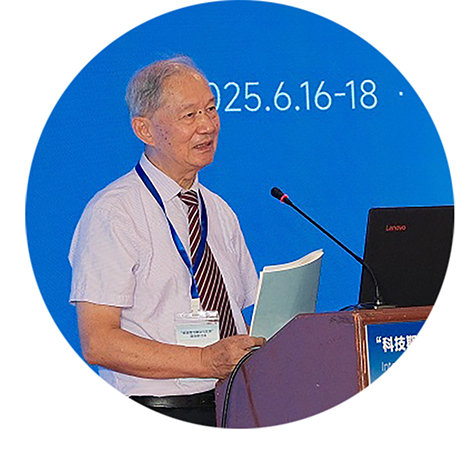
CAS Member Prof. ZHU Zuoyan, prestigious biologist and former general editor-in-chief of the journal cluster Science China, gives a summary as Executive Chair of the Symposium. (Photo: Science China Press)
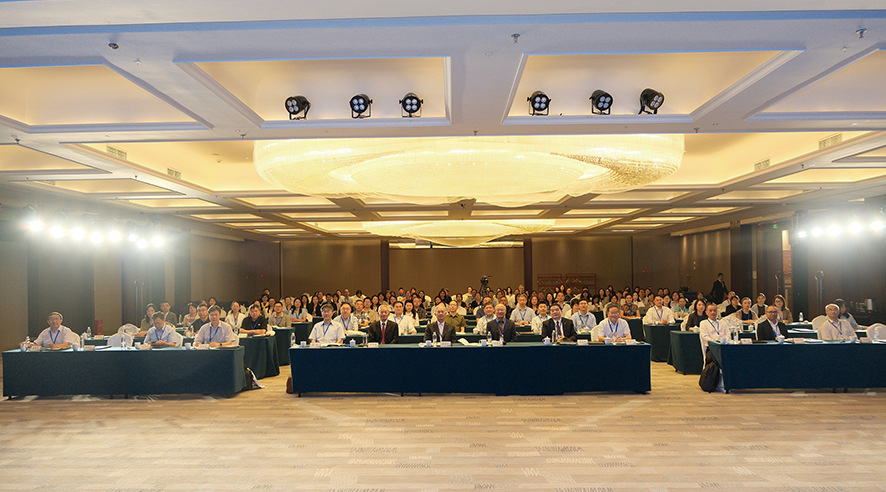
A view of the symposium (Photo: Science China Press)

